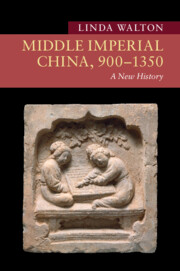Book contents
- Middle Imperial China, 900–1350
- New Approaches to Asian History
- Middle Imperial China, 900–1350
- Copyright page
- Dedication
- Contents
- Figures
- Maps
- Acknowledgments
- Introduction
- 1 The Turbulent Tenth Century
- 2 Song in a Multipolar World
- 3 Schooling, State, and Society in Song and Jin
- 4 An Economic Revolution?
- 5 Cities and Urban Life
- 6 Religious Transformations
- 7 Ways of Knowing
- 8 The Arts of Culture
- 9 Gendered and Generational Lives
- 10 Mapping the Built and Natural Environment
- 11 Sustaining Life and Healing Bodies
- 12 The Mongol Yuan Dynasty in China
- 13 Yuan China in the Mongol Eurasian Empire
- Bibliography
- Index
- New Approaches to Asian History
9 - Gendered and Generational Lives
Women, Men, Children, and Families
Published online by Cambridge University Press: 20 July 2023
- Middle Imperial China, 900–1350
- New Approaches to Asian History
- Middle Imperial China, 900–1350
- Copyright page
- Dedication
- Contents
- Figures
- Maps
- Acknowledgments
- Introduction
- 1 The Turbulent Tenth Century
- 2 Song in a Multipolar World
- 3 Schooling, State, and Society in Song and Jin
- 4 An Economic Revolution?
- 5 Cities and Urban Life
- 6 Religious Transformations
- 7 Ways of Knowing
- 8 The Arts of Culture
- 9 Gendered and Generational Lives
- 10 Mapping the Built and Natural Environment
- 11 Sustaining Life and Healing Bodies
- 12 The Mongol Yuan Dynasty in China
- 13 Yuan China in the Mongol Eurasian Empire
- Bibliography
- Index
- New Approaches to Asian History
Summary
Two aspects of identity shaped the lives of women, men, and children in the Song more than anything else: gender and generation. Gender determined an individual’s place and role both within the family and in society. Generation – position in a descent line – defined an individual’s place and role within the family, and this was also reflected in society. Some individuals and groups lived outside the molds created by gender and generation – Buddhist and Daoist nuns and monks, for example – but these exceptions highlight the norms. Legal cases and government law codes inform us about the official structures that circumscribed daily life in marriage, family, and community. Other sources, such as funerary inscriptions, biographies, and anecdotal collections, allow us to flesh out both the customary and the extraordinary practices of marriage and family life. Extrafamilial relationships, such as those of men and courtesans, friendships between women and between men are also important features of individual social and emotional engagement with others. Due to reticent sources, we know far less about childhood. Ideas of gender, marriage, and family among the Khitan and Jurchen differed greatly from those of Song people, and encounters between and among them generated new configurations for all.
- Type
- Chapter
- Information
- Middle Imperial China, 900–1350A New History, pp. 217 - 244Publisher: Cambridge University PressPrint publication year: 2023

